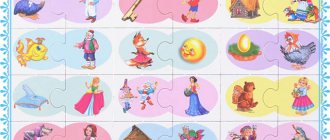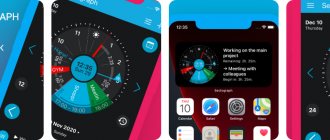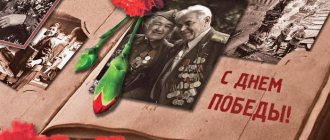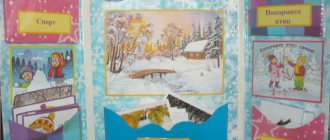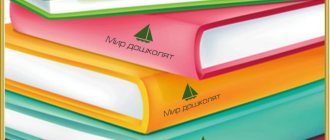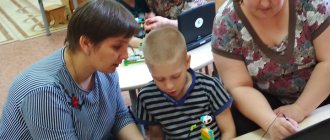Lapbook as an original innovative guide, beautiful and useful
The author of the manual is considered to be American Tammy Dubey. She came up with the idea of filling a small folder with a variety of pictures, pockets, rhymes, and paper crafts to reinforce and preserve the information she had learned with her children. Photos of the first lapbooks found their way onto the Internet and this manual became the property of all concerned parents, educators and teachers. Lapbooking (production of lapbooks) is recognized as an innovative technology with many advantages.
The very name of the manual is translated from English either as a “knee book” or as a “folding book”, and both options are completely fair. Lapbooks are small in size (usually A4 format when folded) and it is convenient for a child to look at them while holding them on his lap. In addition, these wonderful books are full of riddles and secrets, they fold out and have many pockets, inserts, notepads, which in turn open, which is very much to the taste of little researchers and lovers of secrets.
Studying a laptop begins with looking at all the treasures hidden in it.
What game elements are included in the layout and why?
Lapbooks for preschoolers are distinguished by a greater (compared to school) presence of game elements. These are rotating circles, opening windows, moving parts and figures. The first impression of a lapbook is usually for both children and adults: it’s fun, entertaining. But this is how it should be, because preschool children learn about the world through play. The first two or three lessons with a laptop will definitely be devoted to studying its wonderful properties and capabilities as a toy, and only after that the kids will be able to comprehend the useful information contained in it. There is no point in rushing children; their involuntary memory and attention are very developed, and unnoticed by themselves, by manipulating with pockets, circles and pictures, they will learn a fairly extensive amount of information.
It is thanks to such unusual elements that kids really like lapbooks.
Benefits for preschoolers and teachers
Two significant features of the laptop should be noted:
- Interactivity. The child interacts with the folder, rather than just looking at it. Active participation greatly increases interest in the benefit. This is especially important for kinesthetic children (with a predominance of the sense of touch as a means of understanding the world around them), because it is no secret that in the modern educational process visual methods predominate (demonstration of illustrations, videos and slides), as well as the use of music and audio recordings.
- Thematic. It is difficult to collect information on different topics in a small folder; it will be difficult for children to assimilate and understand it, so lapbooks are usually dedicated to one topic, for example, “Autumn”, “Birds”, “Family”. In the older group, which involves a more in-depth study of certain topics, it is possible to cover a more specific subtopic in the lapbook: “Gifts of Autumn”, “Wintering Birds”, “Family Holidays”.
Thus, a modern lapbook is a thematic interactive folder (book) containing systematized and variously designed information.
Usually the title page of a folder already announces its topic.
The purposes for using lapbooks are also very diverse. This includes consolidating everything that children have learned during the project, learning to collect and systematize information, developing creativity and creativity, and fostering a caring attitude towards a product made collectively, and respect for common work. One of the most important objectives of the manual is considered to be the stimulation of cognitive activity in children, the desire to learn and remember new things, and in older preschool age, the awakening of the desire to learn.
Types of lapbooks
Thematic folders come in several types. They are mainly distinguished by the method of application.
Types of benefits depending on purpose and content
It is customary to distinguish the following types of laptops according to their purpose:
- Gaming . This folder is intended for play, together with a teacher or for an independent child, so the main emphasis in it must be on entertainment and ease of perception of information. In addition to movable game elements (windows, circles, sliding pockets-petals), you can put into it the now popular walking games, cards for logic games like “Who am I?”, “What did I wish for?”, small items for the game “What” in my hand?”, “Guess by touch” in a small fabric bag.
- Educational (encyclopedic) . An excellent tool for organized educational activities and individual work to consolidate a specific topic. In such a lapbook you can place not only educational games, memory cards, proverbs, but also interesting facts, folk signs, and quiz questions. Naturally, children will be able to use such a benefit with the help of a teacher.
- Congratulatory . It will be an original and very pleasant gift for a loved one whose tastes and hobbies you know well. A daughter’s best friend would like a lapbook made together with her mother, in which there is room for shared photographs of the girlfriends, a paper doll with a set of dresses and accessories, a hand-sewn rag doll, and a small flat box with children’s jewelry. A lapbook as a gift for a boy can be filled with magnets with images of dinosaurs, cartoon characters, a wooden construction set (its parts are flat and will fit in an envelope), photographs of your favorite athletes, cars.
- Autobiographical . This can be either the story of one child (the parents help the child make the materials and design at home), or the life story of one kindergarten group, which will contain photos, crafts and funny sayings of the kids. When making the “Our Group” lapbook, it is important to distribute the material so that each child receives attention, each is present in some section and in at least one of the photographs.
This New Year's lapbook will be a wonderful gift for the whole family.
Differences in lapbooks depending on the age of children
Equally important is the division of lapbooks according to the age of the children. Thematic folders for primary preschool age are distinguished by a smaller number of pages, interactive elements, more general coverage of information, and large details.
Experts who use lapbooks in depth recommend their use in working with children aged five years and older, but even at a younger age, under the supervision of a teacher, children can work with a lapbook and learn how to put things in order (fold pictures into envelopes, fold and close petals “secrets”, etc.). Folders for the development of color perception in combination with tactile perception (with elements made of multi-colored felt, fabric, fur, burlap) will be useful at this age.
A laptop for little ones has large elements and a minimum of tasks.
For fidgety four-year-olds of the middle group, folders with a large number of moving elements, puzzles, and simple logic problems (“Find a pair,” “What’s extra?”) are suitable. This simultaneously helps to develop children and satisfy their natural curiosity at this age.
Children of the middle group will enthusiastically consolidate their knowledge about fruits and vegetables by placing pictures in the right baskets
Older preschoolers show not only interest in the entertainment possibilities of a lapbook, but also inquisitiveness and consistency in mastering the knowledge contained in it. They are interested in both looking at the image and learning new information about it. Therefore, in pictures in folders, you can place short texts with educational information on the back. Children often ask the teacher to read them, memorize them and retell them to their friends.
The development of thinking and improved memory of children of the sixth or seventh year of life justifies the complication of the material presented. Older preschoolers have access to the games “Remember the Proverb”, “Read the Poem”, “Words-Relatives”, in which it is necessary to reproduce a certain text from a picture. Children of this age are also interested in logical games “What comes first, what comes next”, “Put the pictures in order”, “Part and whole”, “Opposites”. They are placed in a laptop, selecting images in accordance with the theme.
The folder for older preschool age contains much more text information and related tasks
Materials and shape of the interactive folder
The material from which lapbooks are made can be very diverse, the main thing is that it is approved for use in preschool institutions. For this reason, it is better not to use some types of building materials (ceiling tiles, finishing plastic), because inexpensive types of them may be of poor quality, and those that meet the standards “bite” in price. Therefore, it is better to focus on familiar, safe materials: cardboard, whatman paper, colored paper. Cardboard boxes for sweets, cookies, ready-made A4 folders, folders for manual labor, where additional sheets are glued, are also suitable for the base.
The shapes of lapbooks depend on the imagination of their creators:
- Classic rectangular;
- Square, oval, in the form of other geometric shapes;
- Reflecting the theme of the folder, that is, in the form of a nesting doll, a cup, a bird, a flower, a cloud.
When choosing a shaped option, you should remember that the lapbook will be used often, and too small, thin parts, for example, the spout of a teapot or the stem of a flower, may simply fall off.
Recently, a “lapbox” manual has appeared, that is, a “folding box”. It is distinguished by its design, in which parts of the product are folded into a box and secured with tape or fasteners. When the fastening is removed, the laptop “disintegrates”, revealing the contents of the walls, that is, the same envelopes, notebooks, and other elements. This impressive manual is suitable for games and gifts, but is still little used as a teaching tool.
Video: playing with lapbox in a kindergarten group
Lapbooks in the form of books with a small number of pages, folders with inserts and accordion screens have taken root in kindergartens. It is difficult for children to hold the latter on their laps; they are used on a table or rug.
Photo gallery: types of lapbooks used by kindergarten teachers
A traditional version of a lapbook from a ready-made stationery folder with inserts
This lapbook will help young mathematicians navigate the world of numbers and figures.
An original version of a lapbook with knitted elements from handicraft educators
You can't do without letters in a literacy lapbook
A butterfly-shaped folder will teach kids about these wonderful insects.
An ecology laptop will teach kids how to sort garbage
The interactive folder about the ladybug looks elegant and is filled with interesting tasks
Master class for teachers “Lapbook as a means of cognitive development”
#Volgograd region #Educational and methodological materials #Presentation #Methodologist #Educator #Preschool education
What are we talking about? You ask...... About a toy in which there are a lot of interactive things: various hidden interesting elements that reveal themselves during interaction. About a book, a folder that creates the effect of a kinder surprise, which children really like. What is it about the world-famous chocolate eggs that children like so much? Chocolate? No matter how it is! Children are least interested in chocolate.
A laptop creates a similar effect. Children are interested in a surprise, a secret, a riddle, something that is inside, that is still unknown, but now the secret will already be revealed... And this secret will be revealed by them... the children.
“Lapbook as a means of cognitive development” Master class for teachers Prepared by: teacher Almyasheva O.A.
John Dewey is an American philosopher and educator... The founder of the project method.
Time does not stand still; our modern society requires a new education system - “innovative”. The Ministry of Education and Science of the Russian Federation has provided us with a qualitatively new model - the Federal State Educational Standard for preschool education, which defines the priority direction of an individual approach to the child, preserving the very value of preschool childhood and the very nature of the preschooler.
How to make all children active participants in the educational process? How to give every child the opportunity to express themselves? Adults need to arouse curiosity in children. Then curiosity will appear, which is a valuable state of personality, an active vision of the world. At this stage, strong emotions of surprise, joy of learning, delight, and satisfaction with the activity appear. Then children will develop cognitive interest and cognitive activity, which will lead to the development of cognitive abilities.
The introduction of the standard gave us freedom in choosing various technologies, forms and methods of organizing children's activities. Pedagogical activity today has become more professional, scientific and flexible. Firstly, we set ourselves the task of hearing the child - this is exactly the new, fundamental thing that the Standard brought us. The next item on the list of our tasks was the compliance of the subject-spatial developmental educational environment of the group with the properties put forward by the Standard, such as: richness, transformability, variability, multifunctionality, accessibility. And finally, working in the regime of introducing the Federal State Educational Standard, it is impossible to ignore the search for new creative forms of work with students and parents.
The question arises: What innovative educational technologies should I choose? In the search for modern forms and methods of working with children that ensure we achieve our goals, many proposals have been put forward. As a result, several years ago the educational gaming technology “LEPBOOK” was found, which began to be actively implemented.
What is a Lapbook? Lapbook is a relatively new learning tool from America. Literally translated from English, it means “book on the lap,” or as it is also called a thematic folder.
In Russia, Tatyana Pirozhenko introduced this technology for classes with her child and suggested using it in research work with children. She gives the following definition of this term: “this is a homemade paper book with pockets, doors, windows, and movable parts that a child can take out, rearrange, and fold at his own discretion. It collects material on a specific topic. At the same time, a lapbook is not just a craft. This is the final stage of independent research work that the child has done while studying this topic. To fill out this folder, the child will need to complete tasks, make observations, and study the material presented.”
There is currently no scientific literature on lapbook technology. The authors of best practices give different interpretations of this technology: some classify it as a gaming technology, others as a project technology, and others as a research technology. Apparently, this is determined by the leading task of the work using a laptop.
Why do you need a laptop? All Lapbook materials correspond to a specific topic and carry educational and developmental functions. Importance for the teacher: - contributes to the organization of material on the topic being studied within the framework of complex thematic planning. — contributes to the formalization of the results of joint project activities. -promotes the organization of individual and independent work with children. Value for the child: -promotes understanding and memorization of information on the topic being studied -promotes the child’s acquisition of skills in independently collecting and organizing information on the topic being studied -promotes repetition and consolidation of material on the topic covered. A laptop is an excellent assistant in the work of teachers and specialists.
Model Children-parents-teachers and their “Creative interaction” Educational activities - establishing partnerships - Using a laptop in project activities (my family, my city, etc.) - To consolidate the material covered
What is needed to make a Lapbook? 1. Decide on a topic. The theme for the folder can be absolutely anything. As is its complexity. For younger children, you can take “broad, generalizing” topics - winter, autumn, transport, etc. Then you will get a book with the most generally known knowledge. This is well suited for very young children, for whom this knowledge is new. For older children, the topics are narrower, carrying specific information - this will be more productive, for example, snow, bullfinch, sleigh...
2. Take paper and pen and write a plan. After all, a laptop is not just a book with pictures. This is a tutorial. Therefore, it is necessary to think about what the Lapbook should include in order to fully reveal the topic (program content). And for this you need a plan of what you want to tell in this folder. 3. The most interesting stage: Now we need to figure out how each of the points of the plan will be presented in the lapbook. That is, draw a layout. There are no limits to imagination here: presentation can take any form. From the simplest - text, to games and educational tasks. And place all this on different elements: in pockets, notebooks, mini-books, accordion books, rotating circles, envelopes of various shapes, cards, fold-out pages, etc. and so on. All this can be drawn on a draft: an A4 sheet folded in the form of a laptop. This will make it easier to understand how to arrange all the elements later.
The laptop consists of an A-3 format folder (or 2 A-4 format folders) The laptop consists of an A-3 format folder (or 2 A-4 format folders) Basic version of the base Basic version of the base with extension Double basic version of the base
What you will need At this stage, a child can join in the activity.
Thus, we came to the conclusion that lapbook technology is a universal technology that allows teachers to work not only in the field of cognitive development, but also in other areas of child development, and can also be a form of work with parents. The use of lapbooks in working with children has created conditions for reducing hyperactivity in pupils, organizing emotional and personal communication, developing curiosity, focus and concentration. The laptop is a meaningful element of the subject-spatial developmental educational environment of the group and helps to attract parents to joint activities. Examples from the Internet
Reflection “Reflect” on what you thought, What you felt “from” to “before”, Don’t be afraid, as usual, if you say something wrong. Any thought is a door to open, Any feeling is a path to thought, We are all capable - believe it - to look beyond the horizons!
Stages of making a “knee book” (step by step)
If a lapbook is the final stage of a project activity, then it is made simply: take a capacious folder, collect all the materials accumulated during the project (drawings, task cards, children’s flat products) and place them in appropriately sized pockets. Next, children can use the folder to remember their participation in the project and discuss their impressions of it.
But making a laptop can also become a separate project, in which case careful and painstaking preparation is required. It consists of the following points:
- You need to decide on a topic. At younger and middle ages, traditional topics are taken, such as “Seasons”, “Wild and Domestic Animals”, “Vegetables and Fruits”, “Transport”, “Professions”. Older preschoolers will be interested in “Animals of hot countries”, “Space exploration”, “Amazing things in the natural world”, “Protecting our planet”. Together with your parents, you can make folders “Horoscope of our group”, “We work”, “Holidays of our group”, “What is school”, “Professions of our mothers and fathers”, “Ecological kaleidoscope”, etc.
- Drawing up a plan, according to the points of which information on the topic will be searched.
- Making a layout, this also includes choosing the design of individual parts of the laptop. Children and adults discuss what information is best presented in the form of a book, rotating circles, drop-down pockets, windows, and other things. The layout is sketched, and in the future the production of the folder will be based on it.
The layout can be as simple as possible and drawn on a sheet of plain white paper
- Studying the topic, searching for information. Adults should teach the child how to collect information from different sources (books, magazines, excursions, observations). You can organize a trip to a museum or library. If a child owns a computer, he can search for some information on the Internet together with his parents. Do not allow the Internet to become the only source of information - this will significantly narrow your child’s horizons and negatively affect his communication abilities.
Even parents of students can be captivated by making a laptop
MAGAZINE Preschooler.RF
Pedagogical article “Use of a laptop in the educational process of MBDOU”- Babenkova Natalya Viktorovna teacher, MBDOU d/s No. 89, Belgorod
- Avdeeva Marina Ivanovna Soc. teacher MBDOU d/s No. 89, Belgorod
Currently, the concept of “innovation” . Today, innovative phenomena are found in all elements of the pedagogical process, including education and upbringing. Innovations are aimed at creating a basic personal culture, comprehensive development of personal qualities in accordance with age and individual characteristics, and preparing a child for life in modern society. These processes have a positive effect on the quality of education and upbringing in educational institutions, increase the professional level of teachers, create better conditions for the spiritual development of children, and, most importantly, allow for a person-oriented approach to each child.
One of the innovative ways to organize educational activities with preschoolers is a lapbook.
A lapbook, or as it is also called a thematic or interactive folder, is a homemade paper book with pockets, doors, windows, and movable parts that a child can take out, rearrange, and fold at his discretion. It collects material on a specific topic. At the same time, a lapbook is not just a craft. This is the final stage of independent research work that the child has done while studying this topic. To fill out this folder, the child will need to complete certain tasks, make observations, and study the material presented. Creating a lapbook will help consolidate and systematize the material studied, and looking at the folder in the future will allow you to quickly refresh your memory of the topics covered. A laptop will allow you to gain social experience and form a positive attitude towards basic social values.
Depending on the purpose, laptops can be:
- educational;
- gaming;
- congratulatory, holiday;
- autobiographical (a folder-report about some important event in a child’s life: travel, going to a museum, etc.)
They can also vary in shape:
- standard book with two spreads;
- folder with 3-5 spreads;
- accordion book;
- curly folder.
The content of summer books can be varied:
- standard pockets;
- regular and figured envelopes;
- accordion pockets;
- book pockets;
- windows and doors;
- rotating parts;
- protruding parts;
- cards; tags; arrows;
- puzzles;
- blank sheets for notes
Why did this form of work in a preschool educational institution become attractive to us?
Firstly, a lapbook helps a child organize information on a topic of interest at will, and better understand and remember the material.
Secondly, this is a great way to review the material you have covered. At any convenient time, the child simply opens the laptop and happily repeats what he has learned, looking at the book he made with his own hands.
Thirdly, the child independently collects and organizes information.
Fourthly, you can choose tasks that everyone can do (for kids - pockets with cards or animal figures, for example, and for older children - tasks that require the ability to write, etc.)
In the process of such creativity, the child becomes not only the creator of his own book, but also a designer, illustrator, and writer of his own stories, riddles, and poems. This exciting form of work creates conditions for the development of the child’s personality, motivation and abilities.
A laptop is a game, creativity, learning and exploring new things, repeating and consolidating what has been learned, systematizing knowledge and simply an interesting type of joint activity between a teacher, parents and a child..
| Next > |
